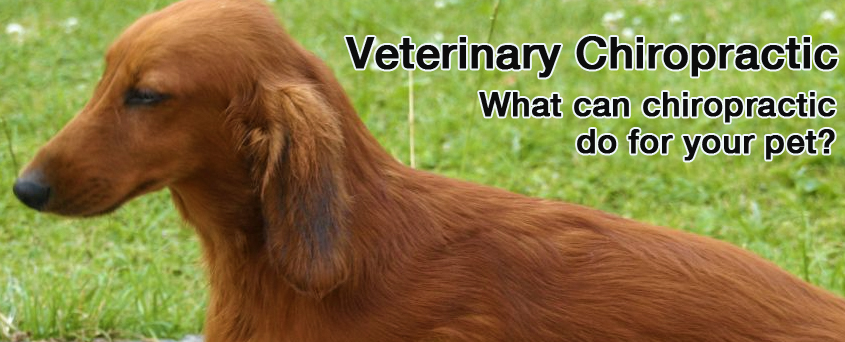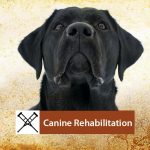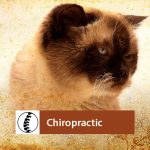Veterinary Chiropractic

Veterinary Chiropractic – History

Ma D.D. Palmer, Discoverer of Chiropractic
It was DD Palmer back in 1895 who was the first person to use the dorsal spinal process of the spinal vertebrae to “re-align” the spinal column.
Veterinary chiropractic was pioneered by veterinarian Dr. Sharon Willoughby. She studied human chiropractic at the Palmer institute and then adapted it with her knowledge of animal anatomy, physiology and movement to veterinary chiropractic. In 1985 she founded and created a curriculum and teaching institute to train veterinarians and human chiropractors at “Options for Animals”, yes the very same place where Dr. Marlene Smith was trained in 1999 and 2000 and where Dr. Radica Raj is currently receiving her training in veterinary chiropractic! Sharon also was the founder of the American Veterinary Chiropractic Association in 1989.
This intensive course at Options teaches veterinarians the specific and professional ways of chiropractic adjustment and it trains the human- trained chiropractors in veterinary anatomy, physiology, movements and specific diseases. You can imagine that there is a big difference in anatomy and function of the spine if you walk upright like us bipeds or if you walk on all fours like our quadrupeds! We can also understand the potential harm that can be done by someone who does not know about these differences. Just like a veterinarian will not consider adjusting a human without the appropriate training, a professional chiropractor will also recognize the ethical and professional dilemma he or she faces when asked to adjust a pet or horse! Horses also differ from dogs and cats by walking on 1 toe only instead of all four (or humans walking on their entire foot!). So a word of caution; please protect your animals and only allow a professional veterinary chiropractic trained person to adjust your pet or horse.
What is it and who needs chiropractic?
Most people have seen a chiropractor and experienced their treatments on their own body. Some of us have discovered that regular “maintenance” visits keeps us pain-free and moving.
Dogs and cats have a total of have 26-27 vertebrae plus the sacrum (7 neck or cervical vertebrae, 13 rib or thoracic and 6-7 lumbar vertebrae ). The sacral vertebra grow together to a solid block by the age of 6 months. The horse has 18 rib or thoracic vertebrae.

The spinal vertebrae connect with each other through several joints; the most important one being the facet joints; their importance is often missed in western medicine. In the middle is the spinal canal with the spinal cord. Between each set of vertebrae is a little hole, called the foramina, through which the nerve exit to supply the muscles, organs and endocrine system with information and signals to act and do their job. The vertebrae are also connected to each other with numerous longer and shorter ligaments, joint capsules and muscles. At the bottom of the spinal canal is a long elastic ligament with numerous pain fibres, called the dorsal longitudinal ligament; it gives us the opportunity to bend our spinal column and also warns us for over stretching or use with pain signals. This ligament also keeps the disc in between the vertebrae , intervertebral disc, in place and prevent them from popping into the spinal canal and damaging the spinal cord. The intervertebral discs are made from cartilage and do not have their own blood supply; they exchange their waste products into the fluids of the intervertebral joints and absorb new fluids from the same area to feed the discs. It is the movement of the vertebrae that squeezes the fluids out of the discs and when not pressed reabsorb their nutrients and fluids again; like squeezing a sponge! Without that exchange the disc will dehydrate, degenerate and then calcify. Now when pressure is exerted on them they will no longer squeeze together but can be popped through the dorsal ligament and pop into the spinal canal, impacting the spine and nerve function. This will result in pain (remember that ligaments contains pain fibres). It also results in disruption of the nerve signals to the muscles resulting in complete or partial paralysis. it may also affect organ and endocrine function.
Regular chiropractic care for those breeds that are predisposed to these type of conditions can help to prevent such incidences. At the bottom, the vertebrae are held together with the ventral longitudinal ligament. Calcification of this ligament from sprains, micro tears or inflammation can be seen on X-rays and sometimes referred to as ventral spondylosis. This calcification will reduce the mobility of the spine significantly!
Who needs chiropractic care?
 As mentioned before all animals (horses, dogs, cats and humans) need chiropractic care, especially those that are more prone to disc calcification or vertebral sub- luxation. This includes the short-legged and long-backed dogs; animals with hip, knee, elbow or other leg problems including ruptured cruciate ligaments. All athletes get regular chiropractic treatment; the same should apply to our high-performance animals such as the dressage horse, hunter-jumpers and endurance horses.
As mentioned before all animals (horses, dogs, cats and humans) need chiropractic care, especially those that are more prone to disc calcification or vertebral sub- luxation. This includes the short-legged and long-backed dogs; animals with hip, knee, elbow or other leg problems including ruptured cruciate ligaments. All athletes get regular chiropractic treatment; the same should apply to our high-performance animals such as the dressage horse, hunter-jumpers and endurance horses.
In the dogs, that would be the agility and fly ball or dock-dogs. For the more geriatric animals, regular chiropractic will give them more mobility and good quality of life. Improper use of the vertebral column can also happen post-surgery or in animals with poor conformation as in people with poor posture. Regular chiropractic care can help to prevent pain and injuries in especially the athlete and older pets.
What are the signs of vertebral subluxations?

Stephanie’s dog Sid
Animals do not always let us know with cries of pain or pain to the touch. In horses we can see tail swishing, kicking, biting or bucking when saddled or mounted; a head bobbing or refusal to collect or change leads. In cats it might show as poor height or depth perception; being hesitant to jump or pulling themselves up with the front claws. In dogs it might show as a reluctance to jump in or out of the car or couch; a reluctance to use stairs to go up or down. In the agility dog it shows up as crashing the jumps, knocking bars, reluctance on A frames and weave poles. A nerve irritation might show up on its pathway with licking or chewing on a leg creating a “lick granuloma”. There might be a urine or bowel incontinence or problems defecating. Incoordination or weakness of the hind legs can also be caused by spinal problems. Or the dog may limp on a front leg if the problem originates in the neck.
Conclusion
Chiropractic for animals has proven to be a very valuable tool in our integrative veterinary medicine tool box. It is very exciting that Dr. Radica Raj is currently taking the veterinary chiropractic course. She is practising learning the hands-on techniques from Dr. Marlene Smith, who has 15 years + experience in chiropractic.
Dr. Marlene Smith has a keen interest in observing the agility dogs in trials. She also participates with her own dog Yuleika. This has given her the advantage of evaluating problems in these dogs and adjusting them and finally see the results of the adjustment right away. Chiropractic adjustment is a skill that can only be learned by experience and this is what she wishes to pass onto Dr. Radica Raj at Phoenix Rising Veterinary Care.









